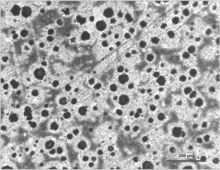- Ductile iron
-
Iron alloy phases - Ferrite (α-iron, δ-iron)
- Austenite (γ-iron)
- Pearlite (88% ferrite, 12% cementite)
- Martensite
- Bainite
- Ledeburite (austenite-cementite eutectic, 4.3% carbon)
- Cementite (iron carbide, Fe3C)
- Beta ferrite (β-iron)
- Hexaferrum (ε-iron)
Steel classes - Crucible steel
- Carbon steel (≤2.1% carbon; low alloy)
- Spring steel (low or no alloy)
- Alloy steel (contains non-carbon elements)
- Maraging steel (contains nickel)
- Stainless steel (contains ≥10.5% chromium)
- Weathering steel
- Tool steel (alloy steel for tools)
Other iron-based materials - Cast iron (>2.1% carbon)
- Ductile iron
- Gray iron
- Malleable iron
- White iron
- Wrought iron (contains slag)
Ductile iron, also known as ductile cast iron, nodular cast iron, spheroidal graphite iron, spherulitic graphite cast iron[1] and SG iron, is a type of cast iron invented in 1943 by Keith Millis.[2] While most varieties of cast iron are brittle, ductile iron is much more flexible and elastic, due to its nodular graphite inclusions.
On October 25, 1949, Keith Dwight Millis, Albert Paul Gagnebin and Norman Boden Pilling received US patent 2,485,760 on a Cast Ferrous Alloy for ductile iron production via magnesium treatment.[3]
Contents
Metallurgy
Ductile iron is not a single material but is part of a group of materials which can be produced to have a wide range of properties through control of the microstructure. The common defining characteristic of this group of materials is the morphological structure of the graphite. In ductile irons, the graphite is in the form of spherical nodules rather than flakes (as in grey iron), thus inhibiting the creation of cracks and providing the enhanced ductility that gives the alloy its name.[5] The formation of nodules is achieved by addition of nodulizing elements, most commonly Magnesium (note Magnesium boils at 1100C and Iron melts at 1500C) and, less often now, Cerium (usually in the form of Misch metal), into the melt.[6] Tellurium has also been used. Yttrium, often a component of Misch metal, has also been studied as a possible nodulizer.
Besides the requirement that the graphite be manipulated into the spheroidal shape, the ferrite and pearlite ratios can be controlled through alloying, shakeout temperature control or post-casting heat treatment to vary the relative amounts pearlite and ferrite from 0% pearlite and 100% ferrite, to 100% pearlite and 0% ferrite. The control of the pearlite and ferrite ratio manipulates the tensile, yield and elongation characteristics of the ductile iron to produce numerous standard grades of material.
"Austempered Ductile Iron" (ADI) was invented in the 1950s but was commercialized and achieved success only some years later. In ADI, the metallurgical structure is manipulated through a sophisticated heat treating process. The "aus" portion of the name refers to austenite.[7]
Composition
A typical chemical analysis of this material:
- Iron
- Carbon 3.3 to 3.4%
- Silicon 2.2 to 2.8%
- Manganese 0.1 to 0.5%
- Magnesium 0.03 to 0.05%
- Phosphorus 0.005 to 0.04%
- Sulfur 0.005 to 0.02%
Other elements such as copper or tin may be added to increase tensile and yield strength while simultaneously reducing elongation. Improved corrosion resistance can be achieved by replacing 15% to 30% of the iron in the alloy with varying amounts of nickel, copper, or chromium.
Applications
Much of the annual production of ductile iron is in the form of ductile iron pipe, used for water and sewer lines. It competes with polymeric materials such as PVC, HDPE, LDPE and polypropylene, which are all much lighter than steel or ductile iron.
Ductile iron is specifically useful in many automotive components, where strength needs surpass that of aluminum but do not necessarily require steel. Other major industrial applications include off-highway diesel trucks, class 8 trucks, agricultural tractors, and oil well pumps.
See also
References
- ^ Smith & Hashemi 2006, p. 432.
- ^ Modern Casting, Inc
- ^ US patent 2485760, Keith Millis, "Cast Ferrous Alloy", issued 1949-10-25
- ^ Asst. Prof. Yaqub, Ejaz, Asst. Prof. Arshad, Rizwan (2009). "ME-140 Workshop Technology - Slide 25" (in English) (images). Air University. http://www.scribd.com/doc/41574523/Lecture-1-Part-II-Engineering-Materials. Retrieved 2011-10-30.
- ^ http://www.ductile.org/didata/Section2/2intro.htm
- ^ Gillespie, LaRoux K. (1988), Troubleshooting manufacturing processes (4th ed.), SME, p. 4-4, ISBN 9780872633261, http://books.google.com/books?id=SX_SO_CkiUIC&pg=PT195&lpg=PT195.
- ^ "ADI the Material". ADI Treatments Ltd. http://www.aditreatments.com/background.php. Retrieved 2010-01-24.
Bibliography
- Smith, William F.; Hashemi, Javad (2006), Foundations of Materials Science and Engineering (4th ed.), McGraw-Hill, ISBN 0-07-295358-6.
External links
 Media related to Ductile iron at Wikimedia Commons
Media related to Ductile iron at Wikimedia Commons- Ductile Iron Society
- Ductile Iron Pipe Research Association
Categories:- Ferrous alloys
Wikimedia Foundation. 2010.

